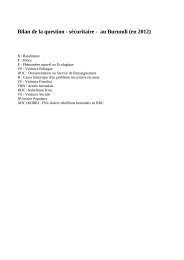Q3 Q4
g8iBkai
g8iBkai
You also want an ePaper? Increase the reach of your titles
YUMPU automatically turns print PDFs into web optimized ePapers that Google loves.
Methodology<br />
The current 32 nd issue of the FRAN Quarterly<br />
is a comparative analysis of FRAN<br />
data collected between April and June<br />
2016 and exchanged between 31 Member<br />
State border-control authorities within the<br />
framework of the Frontex Risk Analysis<br />
Network. The report presents the results<br />
of statistical analysis of quarterly changes<br />
of irregular-migration indicators aggregated<br />
at the level of the event. Analytical<br />
reports exchanged by Member States<br />
were also used for interpretative purposes<br />
and to provide qualitative information, as<br />
were other available sources of information,<br />
such as Frontex Joint Operations.<br />
Precise definitions of Indicators 1 to 6,<br />
aimed at harmonising the data exchanged<br />
at EU level, were presented in the annexes<br />
of the Q1 and Q2 reports of 2009 and are<br />
therefore not repeated here.<br />
The FRAN data exchange has been in<br />
place since September 2008. Data are<br />
exchanged through the ICONet Internet<br />
platform, an interest group of the European<br />
Commission’s CIRCA server. Member<br />
State monthly data are based on a country<br />
template prepared by the Frontex Risk<br />
Analysis Unit. The deadline for submitting<br />
data for each month is the 20th day of the<br />
subsequent month, with the exception of<br />
the end-of-year data, which are requested<br />
by 15 January each year. For this 32 nd issue<br />
of the FRAN Quarterly, the target for<br />
Member States to upload the monthly<br />
data was thus 20 July 2016. In principle,<br />
data submitted subsequent to this date<br />
will be reflected in the next FRAN Quarterly,<br />
except in cases where clarification<br />
is needed in order to proceed with comprehensive<br />
analysis.<br />
In January 2012, the European Union Document-Fraud<br />
Risk Analysis Network (EDF-<br />
RAN) was formed as a specialist forum<br />
to oversee the exchange and analyses of<br />
detections of document fraud at the EU’s<br />
external borders and on all international<br />
flights to the EU. The data were backdated<br />
and merged with those exchanged under a<br />
pilot Tailored Risk Analysis released in 2011.<br />
At the beginning of 2014, Member States<br />
started to regularly collect quantitative<br />
information on indicators related to secondary<br />
movements. Moreover, in July 2014,<br />
Frontex organised workshops for Member<br />
State experts to gather their insights<br />
and analyse available data. Their input<br />
was essential for the analysis of intra-EU/<br />
Schengen secondary movements of undocumented<br />
migrants.<br />
4 of 37






